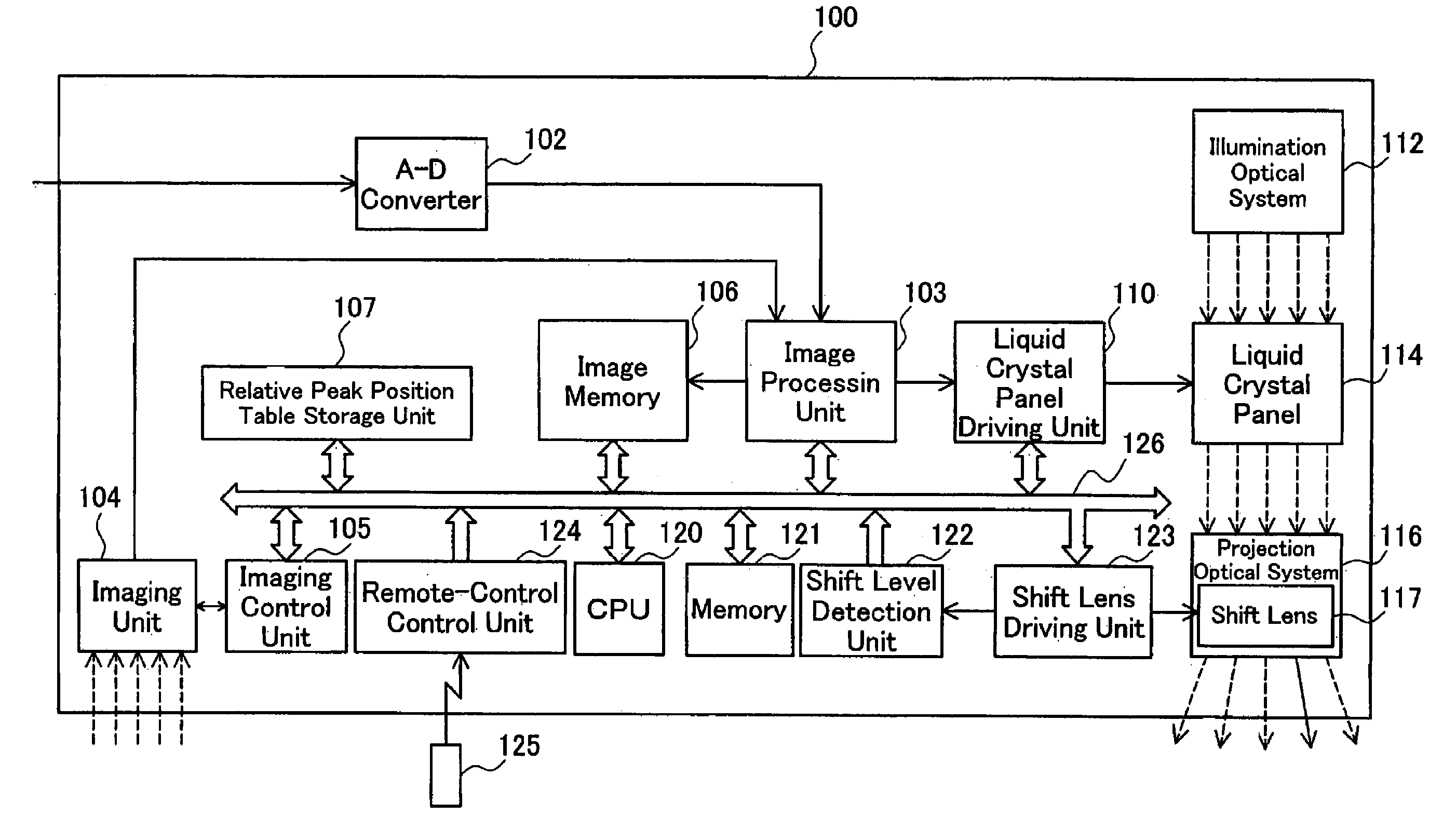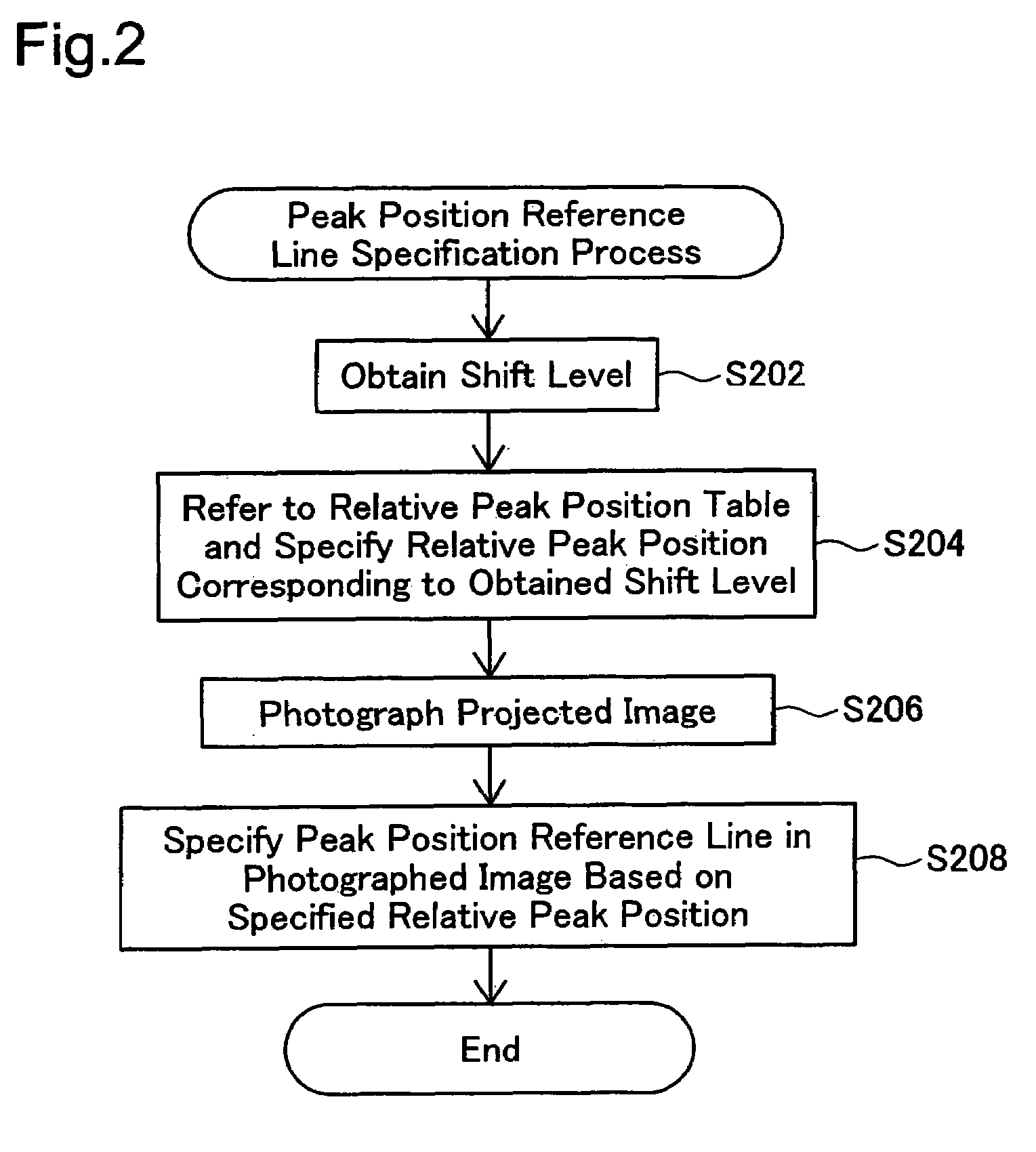Projector and processing line specification method
a technology of processing line and projector, applied in the field of projector, can solve the problems of inadequate and inaccurate keystone correction and other image processing operations, inaccurate identification of peak position in photographed images, and conventional methods, etc., and achieve the effect of adequate and accurate keystone correction
- Summary
- Abstract
- Description
- Claims
- Application Information
AI Technical Summary
Benefits of technology
Problems solved by technology
Method used
Image
Examples
embodiment
A. Embodiment
A1. General Configuration of Projector
[0052]FIG. 1 schematically illustrates the configuration of a projector 100 in one embodiment of the invention. The projector 100 of this embodiment has the functions of photographing a projected image on a screen, identifying the position of maximum luminance in the photographed image, and making keystone correction, like the conventional projector PJ shown in FIGS. 5 and 6. The projector 100 of the embodiment determine a peak position on a specified horizontal line and accordingly identifies the position of maximum luminance in the photographed image, like the conventional projector PJ.
[0053]As illustrated, the projector 100 includes an A-D converter 102, an image processing unit 103, an imaging unit 104, an imaging control unit 105, an image memory 106, a relative peak position table storage unit 107, a liquid crystal panel driving unit 110, a CPU 120, a memory 121, a shift level detection unit 122, a shift lens driving unit 123,...
modified example 1
B1. Modified Example 1
[0099]In the structure of the embodiment, the projection orientation of the projector 100 is set to locate the optical axis point on the top side of a projected image at the bottommost position of the shift lens 117. Such projection orientation is, however, not restrictive. The projection orientation of the projector 100 may be set to locate the optical axis point above the top side of the projected image at the bottommost position of the shift lens 117.
[0100]In this modified arrangement, the optical axis point moves upward to become out of the projected image at a lower shift limit in the course of a downward shift of the shift lens 117. The relative peak position table accordingly has the relative peak position ‘100’ set corresponding to all the shift levels of and below the lower shift limit that locates the optical axis point on the top side of the projected image. Even when the optical axis point is out of the projected image, a horizontal line that is clo...
modified example 2
B2. Modified Example 2
[0102]In the relative peak position table used in the projector 100 of the embodiment, the highest relative peak position ‘100’ is set corresponding to the shift level ‘−100’ representing a shift to the bottommost position. The relative peak position corresponding to the shift level ‘−100’ may be slightly lower than the highest relative peak position ‘100’, for example, ‘99’ or ‘98’.
[0103]Under the condition of the shift level ‘−100’, the projection orientation of the projector 100 is set to locate the optical axis point on the top side of the projected image. The top side of the projected image forms a boundary between the bright projected image area and the dark non-projection area in the photographed image. The detected luminance values of the pixels on the top side of the projected image may be lower than the actual level due to the low luminance values of the adjoining darker area. This may cause difficulty in accurate identification of the position of max...
PUM
 Login to View More
Login to View More Abstract
Description
Claims
Application Information
 Login to View More
Login to View More - R&D
- Intellectual Property
- Life Sciences
- Materials
- Tech Scout
- Unparalleled Data Quality
- Higher Quality Content
- 60% Fewer Hallucinations
Browse by: Latest US Patents, China's latest patents, Technical Efficacy Thesaurus, Application Domain, Technology Topic, Popular Technical Reports.
© 2025 PatSnap. All rights reserved.Legal|Privacy policy|Modern Slavery Act Transparency Statement|Sitemap|About US| Contact US: help@patsnap.com



